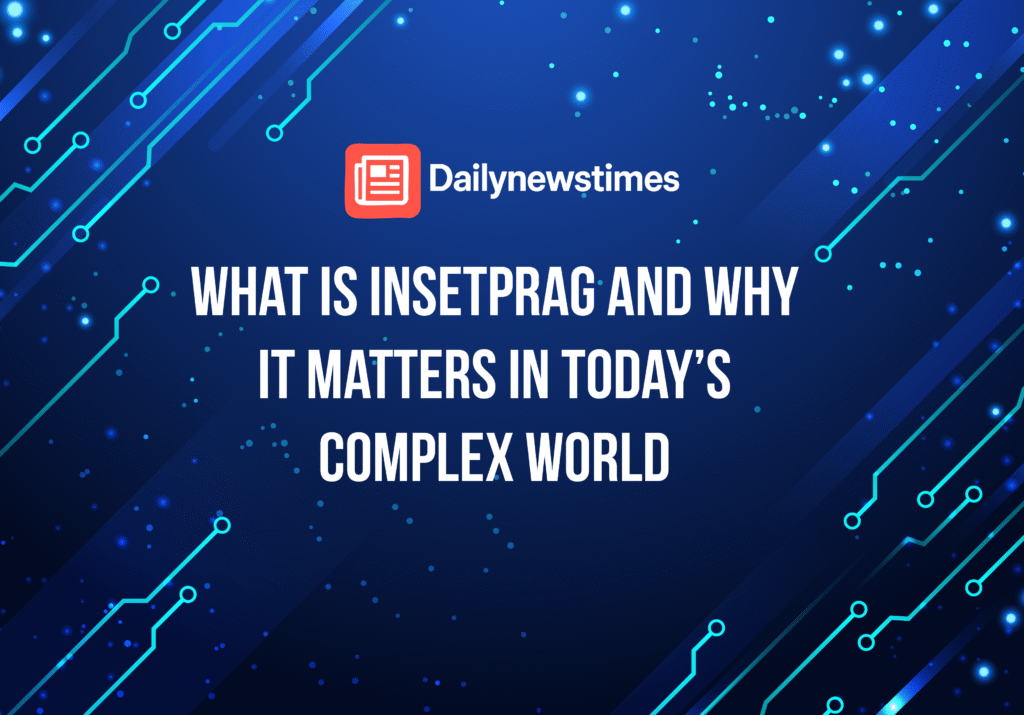You may have stumbled on the term Insetprag recently—on a tech podcast teaser, a design blog, or even in a policy think tank article—and wondered what it means. It’s not a typo. Instead, Insetprag refers to a new conceptual framework combining context, pragmatics, and systems thinking. That might sound abstract, but it matters—especially if you’re working with AI, smart cities, or policy simulations. This article will break down what Insetprag is, why it’s popping up now, and how you can actually use it in real projects.
what exactly is insetprag
Insetprag merges two ideas: inset, meaning nested context, and pragmatics, the study of language and logic in practical settings. As Cordless.io puts it, it’s a way to build systems that adapt their decision rules based on layered contexts—technical, ethical, social—all at the same time. Instead of static logic, systems using Insetprag update their rules as situations unfold.
It’s popping up in smart-city planning, AI language models, policy modeling and beyond, as a method to handle complexity without oversimplifying reality.
why insetprag is emerging now
navigating complex systems
We live in a world where everything’s interconnected. A policy tweak in traffic affects climate, social equity, public health—and it all interacts. Traditional models with fixed logic just can’t keep up.
AI meets ethics and context
Researchers behind Dot Magazine argue Insetprag is vital when building AI that’s not just intelligent, but also contextually aware—think chatbots that adapt tone based on user mood or legal systems that incorporate cultural norms.
policy and public systems
In government and NGOs, Insetprag helps by layering real-time community feedback into urban planning or pandemic responses. Imagine a simulation that not just models infection rates, but also adjusts messaging based on trust metrics.
where insetprag is already being used
smart city planning
In several European projects, planners simulate infrastructure with multiple context layers—citizen behavior, weather impact, economic swings—using frameworks inspired by Insetprag to dynamically adjust outcomes.
AI language models
Cutting-edge translation tools are incorporating pragmatics so they can adapt tone, regional slang, and context. Insetprag’s layered logic helps avoid literal-but-awkward translations.
ethical decision-making systems
Analysts are exploring justice systems that adjust prediction models based on legal context and community values—a kind of human-in-the-loop Insetprag model in practice.
insetprag vs traditional systems thinking
| Feature | Traditional Systems | Insetprag Approach |
|---|---|---|
| Rule structure | Fixed | Contextual, nested and adaptable |
| Input/output logic | Linear | Feedback-driven and recursive |
| Decision-making | Static | Situational and multi-layered |
| Adaptability | Limited | High — nested switch based on context |
| Transparency | Clear flowcharts/models | Complex, but designed to explain shifting rules |
Traditional systems serve well for stable conditions, but for “living” contexts—like city planning or human interaction—Insetprag excels.
challenges of putting insetprag in practice
computational cost
Embedding nested layers of context means more memory and compute power—they’re not light-weight.
user understanding
Systems that change logic dynamically can feel black-boxy. Ensuring transparency for users or stakeholders is essential.
governance clarity
If rules shift based on context, who decides which context reigns? Aligning ethical oversight is tricky.
lack of standards
Insetprag is new—so there’s no ISO or standard approach yet. Frameworks vary between projects, making comparisons tough.
expert insights and trend analysis
According to a piece in Dot Magazine, Insetprag is a “smart system design approach that uses context to make better decisions in real time.” Meanwhile, The Pill Magazine compares it to lean methodologies—emphasizing flexibility, ongoing learning, and adaptive improvement.
In short, experts see Insetprag as the next step beyond agile or systems thinking—injecting awareness and reflexivity deep into design.
tips to apply insetprag in your work
- Start small – add context layers slowly (like user mood or location) in existing models
- Document logic shifts clearly, so stakeholders understand why rules change
- Build transparent overrides—especially with AI, so humans can take control
- Iterate continuously—each layer should evolve based on real-world feedback
- Use simulations to test how nested rules interact before full deployment
pros and cons of using insetprag
✅ Pros
- Adapts to real-world complexity
- Makes AI and systems mindful of context
- Aligns systems with values, ethics, and local norms
⚠️ Cons
- More expensive to build and maintain
- Harder to audit and explain
- No one-size-fits framework yet
conclusion actionable takeaways
Insetprag is a new kind of thinking—less about rigid rules, more about layered pragmatics. It’s not just philosophy—it’s a signal of how future systems, AI and policies must handle complexity. If you’re in urban planning, AI, policy modeling or smart infrastructure—you should explore Insetprag. It’s not easy, but it offers flexibility and realism that older models just can’t.
Start experimenting, layer context, document the logic, and stay grounded in ethics and transparency. In a chaotic world, Insetprag might be one of the smartest ways to build systems that actually work with our complexity—not against it.
FAQs
What is Insetprag?
A framework for embedding nested, context-aware pragmatic logic into adaptive systems.
Where is it used today?
In smart city simulations, AI language models, policy design, and justice system tools.
How is it different from agile or traditional systems?
Insetprag adapts rules dynamically based on layered contexts—not just iterative delivery.
Is Insetprag hard to implement?
Yes, it requires more tech, clearer transparency, and careful ethics oversight.
Why try it now?
Because our systems face more complexity than anytime before. Insetprag offers a clearer way to manage it.


